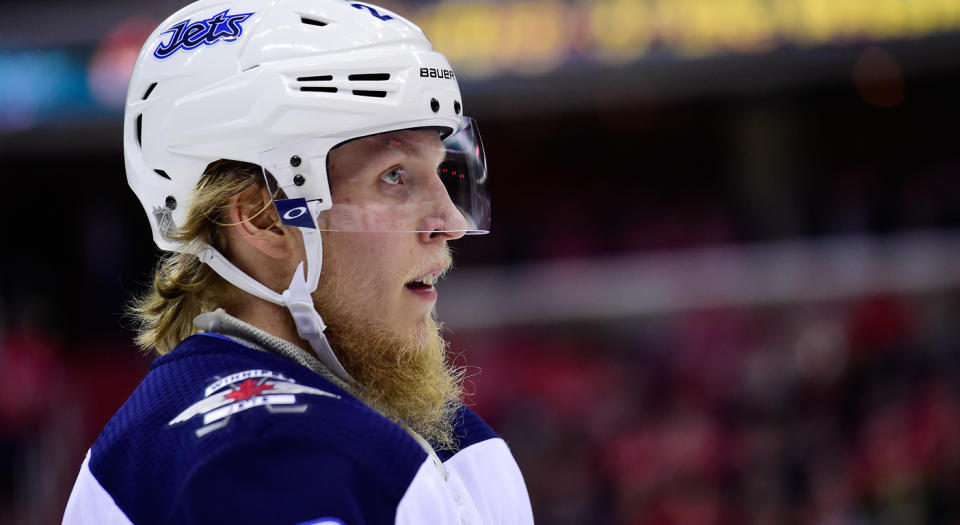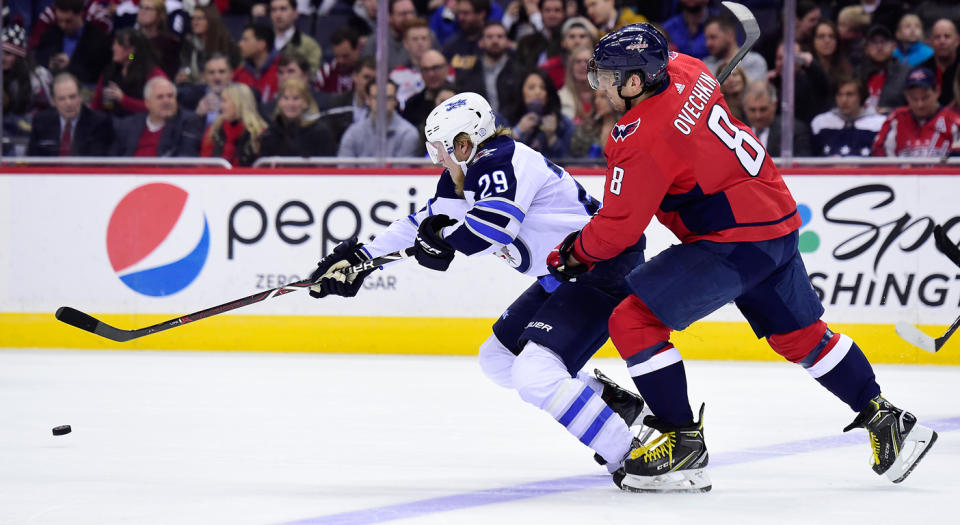What in the world will Patrik Laine earn on his next contract?

In the coming weeks (and maybe months), we’ll have a complete view of just how accomplished Patrik Laine winds up being following his first two NHL seasons.
And not long after that, we’ll know just how rich.
One of several stars lighting up the league on an entry-level salary, Laine is free to sign any big-money extension tabled in his direction from the Winnipeg Jets come July 1. And based on the extent to which he’s differentiated himself, ascending to — and maybe beyond — the elite tier of NHL marksmen in just two (teenage) seasons, the expectation should be that he will.
The investment in Laine will, invariably, lend itself to broader points of discussion as it pertains to the league — and perhaps to an extent greater than the tremendous talents who signed their first deals beyond entry level, including Connor McDavid and Jack Eichel, as well as the one that awaits Laine’s most direct player-to-player rival, Toronto Maple Leafs star Auston Matthews.
Why? For one, Laine isn’t those players.
Let’s explore the factors that will play into Laine’s contract negotiations in an effort to arrive at a number that makes sense for him, and the Jets.
Team dynamic
There is a benefit to routinely signing players to team-friendly contracts beyond, y’know, basic per-player production on the dollar and corresponding cap space. Correctly slotting players establishes a natural pecking order, and in some ways, a self-regulation system in cost control.
Last summer, David Pastrnak and the Boston Bruins were locked in a staring contest, spending the offseason negotiating the framework of his first contract out of entry level. Finally, after missing the first day of training camp, Pastrnak signed a six-year deal that carried an annual cap hit of $6.67 million. That was one month after Leon Draisaitl (in a far less exhaustive negotiation process) agreed to an eight-year, $68-million contract with the Edmonton Oilers.
Pastrnak finished with just seven fewer points than Draisaitl, but also had five more goals. And yet, he was forced to settle for $28 million less in terms of guaranteed money.
The most significant factor in these negotiations were the contracts that already existed on the teams’ payrolls. No way was Pastrnak worth many millions more than Patrice Bergeron and Brad Marchand (he did land between the two), while the Draisaitl camp simply wouldn’t agree to slot several financial stratospheres from the Connor McDavid finanicial orbit.
McDavid earning twice the salary of Marchand (beginning next season) had as much to do with the results of those negotiations than anything.
Unfortunately for Laine, his reference point is more Marchand, less McDavid.
Like Pastrnak, Laine might be considered third in terms of importance on his team behind Blake Wheeler and Mark Scheifele. Combined, the two stars take up $11,725,000 total — or $775,000 less than McDavid on an annual basis. And the worst part is, Scheifele is just two summers removed from agreeing to a deal that pays him only a shade over $6 million annually.
Laine will command more than both Scheifele and Wheeler when he signs his deal, though Wheeler’s is up in 2019 when Laine’s entry-level contract actually expires. But the two points of reference on the Jets payroll will most certainly drag his number below its actual potential.
Around the league

Patrik Laine should have every incentive to continue on his tornado pace; not just for the sake of capturing the Rocket Richard Trophy now in reach after racking up 16 goals in his last 12 games, but to preserve his strongest bargaining chip in future negotiations.
As it stands right now, Laine has outscored everyone in the NHL since he broke into the league last season. And despite “taking the minus” Monday in Washington, falling behind in this season’s goal scoring race in his head-to-head matchup with Alex Ovechkin, Laine did answer his likeness’s historic two-goal performance with his 41st of the season — maintaining a two-goal lead over the greatest to do it in total goals over the last two years.
Further to that, Ovechkin and Evgeni Malkin are the only players to have eclipsed 80 goals in their first two seasons in the post-lockout era. With 77 so far and 13 games left in his sophomore season, the expectation is that he will pass Malkin’s 80, and author the most prolific two-season goal scoring start since Ovechkin lit the lamp 98 times in his debut seasons.
The question is, what’s that worth?
Firstly, it begs mentioning that Ovechkin and Malkin each collected in excess of 100 assists in their first two seasons, while Laine has just 51 to this point. So while he’s a proven comparable, he will wind up producing in the range of 25 percent less total offence as a 0.9 points-per-game scorer.
Still, putting the puck in the net is the most difficult thing to do with regularity in the NHL — and he’s proven to be the best to come along in a decade. That equates to dollars.
Ovechkin signed the richest contract in history — 13 years, $124 million — midway through the final season on his entry-level contract. Malkin agreed to a five-year contract that matched Sidney Crosby’s $8.7 million annual salary in the summer that followed his second season. This proved wise, as he later inked an eight-year, $76-million contract.
Those deals helped establish the ceiling in the NHL. Over time, though, the growth and success of the league has pushed the upper limit higher.
Inflation
In the 10 years between Ovechkin signing his record contract and Laine becoming able to negotiate a future contract with the Jets, NHL teams will have been afforded an additional $30 million to spend on players.
This explains why real dollars don’t give us an accurate basis to compare player salaries. Instead, we look to percentage.
When adjusting for inflation, and taking into account the salary cap’s expected rise to $82 million this summer, the value on the contact Ovechkin signed at an unprecedented percentage of the salary cap a decade ago would be worth in the range of $15.5 million a season.
Now, while Laine’s camp will use this in negotiations, the Finnish star obviously will fall well short of the segment Ovechkin secured. That’s because he’s just not Ovechkin (despite his similarly lethal shot), nor is he Connor McDavid, who established an upper limit last summer, which likely won’t soon be exceeded.
Still, it illustrates the mammoth range that will be discussed when Laine’s camp does indeed hunker down with Kevin Cheveldayoff and the Jets management team: Scheifele to an adjusted-era Ovechkin.
What makes sense?
Perhaps it’s simple. Maybe all that separates Laine from Ovechkin, at this point, is the decade of growth in the NHL.
Is it possible that Ovechkin’s current $9.538 million salary makes the most sense on a long-term contract for Laine?
Who says no?
More NHL coverage on Yahoo Sports:



